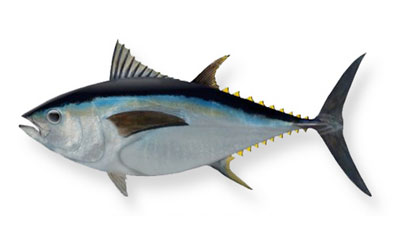
Atlantic Bluefin Tuna

Adults are typically 3m in length, making the Atlantic tuna one of the largest bony fishes and the largest of all tuna species. Adults average 130-680kg.
There are 2 populations of Atlantic Bluefin tuna: a smaller western population, which spawns in the Gulf of Mexico, and a larger eastern population, which spawns in the Mediterranean Sea.
These 2 populations are not completely separate, however. Adults and juveniles from both populations feed together, particularly off the east coast of North America and in the central Atlantic.
Atlantic Bluefin tuna spawn just once a year and do not reach reproductive maturity until they are 8-12 years old. This makes Bluefin tuna more vulnerable to overfishing than some of the smaller tuna species that can spawn several times in a year. Female Atlantic Bluefin can produce up to 10 million eggs per year, but just a small fraction survives to adulthood.
Pacific Bluefin tuna

Pacific Bluefin tuna are generally smaller than their Atlantic cousins, reaching a maximum length of 3m and a maximum weight of 540kg.
In the eastern Pacific, Bluefin tuna have been spotted from Baja California as far north as the Gulf of Alaska, though they rarely venture further north than Oregon. In the western Pacific, Bluefin tuna can be found as far north as Russia’s Sakhalin Island and as far south as New Zealand.
Pacific Bluefin tuna spawn between Japan and the Philippines, in April and August. They reach reproductive maturity at around 5 years and 60kg.
Yellow fin tuna

Yellow fin tuna can live up to 6 or 7 years, grow to a length of 2m and weigh 200kg.
Yellow fin are highly migratory and are found throughout the Pacific, Atlantic and Indian Oceans (between 40 degrees north and 40 degrees south but concentrated between 20 degrees north and 20 degrees south).
Yellow-fin tunas tend to school by size with other yellow-fin as well as with other species. Juvenile yellow-fin, for example, form schools with skipjack tuna and juvenile big-eye tuna in shallow waters.
Yellow-fin tuna reach reproductive maturity around 2-3 years of age. Spawning season varies by ocean, all yellow-fin tunas spawn frequently and several times during the season.
Big-eye tuna

Big-eye tuna are generally smaller than blue-fin and larger than yellow-fin. They reach a length of between 60 and 250cm, and weigh around 180kg, and live 10 to 12 years.
Big-eye are a highly migratory species found throughout the Atlantic, Pacific and Indian Oceans between 30 degrees north and 20 degrees south. They can be found from the surface to 250m deep, depending on the age of the big-eye and where prey can be found.
Big-eye tuna reach reproductive maturity around age 3, and at around 1m in length. They spawn throughout the year in tropical waters.
Albacore

Albacore can live for around 12 years. They can grow up to 140cm and weigh up to 45kg.
Albacore are a highly migratory species found throughout the Pacific, Atlantic and Indian Oceans – between 40 degrees north and 40 degrees south – and in the Mediterranean Sea. Young albacore are mainly found in warmer, shallow waters.
Albacore reach reproductive maturity around 5 years of age and 1m in length. Albacore spawn in the spring and summer.
Skipjack tuna

Skipjack tuna is an important commercial fish. Although it is not currently threatened, the purse seine nets and other unsustainable methods used to catch skipjack tuna results in by-catch of other vulnerable species, including dolphin and other juvenile tuna species.
Skipjack can live as long as 8-10 years, growing up to 1m long and weighing around 18kg.
Skipjack are highly migratory and are found throughout the Pacific, Atlantic and Indian Oceans between 45 degrees North and 40 degrees South. Skipjack usually swim near the surface at night and can dive up to 250m during the day. Large schools of adult skipjack tuna often mix with juvenile yellow-fin and big-eye tuna.
Skipjack mature early, around age 1 and at about 16 inches long. Skipjack spawn throughout the year.